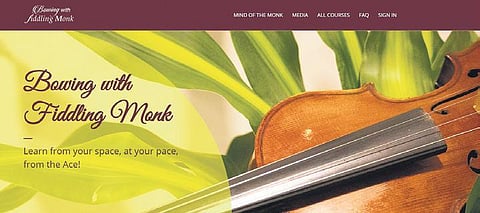

Violinist Kumaresh gave his first performance at age five. By the age of 10, he had already completed 100 concerts. Now, he has designed a digital learning platform for the Indian violin, titled ‘Bowing with Fiddling Monk’ (fiddlingmonk.com) — as he’s fondly known as the Fiddling Monk. It claims to be the first platform to provide interactive digital learning experience of violin in India. “My aim is to make music timeless and boundary-less,” says Kumaresh, 48, adding that he has tailored the lessons for a fun and challenging experience. Excerpts:
When did you conceptualise Bowing with Fiddling Monk?
Pre-covid, many of my students had requested for one-on-one online classes. With my concerts, composing and recordings, I could accommodate only a few. So, I started looking for different avenues. Initially, I sent pre-recorded video lessons to my students, and following their encouragement, decided to create an e-learning portal where enthusiasts from across the globe can access the lessons at their own pace and in their own space.
Who can learn and what are the courses like?
Anyone between five and 80, with a thirst for learning, can enrol. There are six courses, divided into more than 100 lessons on the various stages of learning the violin. The lessons are uploaded as HD videos shot in multiple angles to capture the right and left-hand technique. This includes swara exercises that focus on note positions; bowing exercises that help a student in multiple note bowing; and innovative left-hand finger position exercises as also guidelines to tuning, bowing, and traversing on multiple octaves. There are repertoires — chocolate melodies for kids, varnams and krithis for advanced students, etc., — that focus on students at various learning stages. To graduate to the next level, students are evaluated on the basis of their multiple assignments.
What changes have you seen over the years in the classical music arena?
In the last five decades, I have seen at least three generations of musicians and music lovers. Each generation brings about a new wave of thought process that is innovative and thus widens the horizons of what we perceive as ‘classical’ music.
Apart from our regular Carnatic music concerts, along with my brother Sri R Ganesh, I used to do a lot of ‘fusion’ music in the early 1990s. Today, fusion music is the new classical, cool to perform in different landscapes. The interest in learning the Indian Violin has risen with time.
You hail from a family of musicians. Did you feel the pressure to join the league?
It was a natural progression. Music was the language spoken at home. So, even before I
realised the concept of a career, my brother and I made a name in the Carnatic music arena. We were honoured by the Govt of Tamil Nadu as the State Artistes when I was 17. I perform with the same enthusiasm I had back then.
What do awards mean to you?
Awards act as manure for an artiste’s creative vein, inspiring them to move ahead. These don’t have to be cups and trophies, even a tear drop from a listener’s eyes is an award.